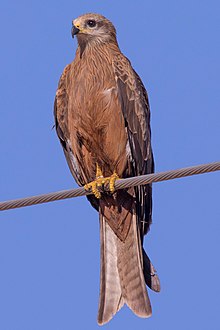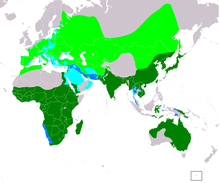
Back Swartwou AF Milvus migrans AN حدأة سوداء Arabic حداه سوداء ARZ চিলনী AS Milvus migrans AST Qara çalağan AZ Төйлөгән BA Каршун чорны BE Черна каня Bulgarian
| Black kite | |
|---|---|

| |
| M. m. affinis, Australia | |
| Calls | |
| Scientific classification | |
| Domain: | Eukaryota |
| Kingdom: | Animalia |
| Phylum: | Chordata |
| Class: | Aves |
| Order: | Accipitriformes |
| Family: | Accipitridae |
| Genus: | Milvus |
| Species: | M. migrans
|
| Binomial name | |
| Milvus migrans (Boddaert, 1783)
| |
| Subspecies | |
|
5, see text | |

| |
| Range of black and yellow-billed kites Breeding Resident Non-breeding Passage
| |
| Synonyms | |
| |

The black kite (Milvus migrans) is a medium-sized bird of prey in the family Accipitridae, which also includes many other diurnal raptors. It is thought to be the world's most abundant species of Accipitridae, although some populations have experienced dramatic declines or fluctuations.[2] Current global population estimates run up to 6.7 million individuals.[1]
Unlike others of the group, black kites are opportunistic hunters and are more likely to scavenge. They spend much time soaring and gliding in thermals in search of food. Their angled wing and distinctive forked tail make them easy to identify. They are also vociferous with a shrill whinnying call.
The black kite is widely distributed through the temperate and tropical parts of Eurasia and parts of Australasia and Oceania, with the temperate region populations tending to be migratory. Several subspecies are recognized and formerly had their own English names. The European populations are small, but the South Asian population is very large.
- ^ a b BirdLife International (2020). "Milvus migrans". IUCN Red List of Threatened Species. 2020: e.T181568721A181571544. doi:10.2305/IUCN.UK.2020-3.RLTS.T181568721A181571544.en. Retrieved 13 November 2021.
- ^ Cite error: The named reference
RaptorsWorldwas invoked but never defined (see the help page).
